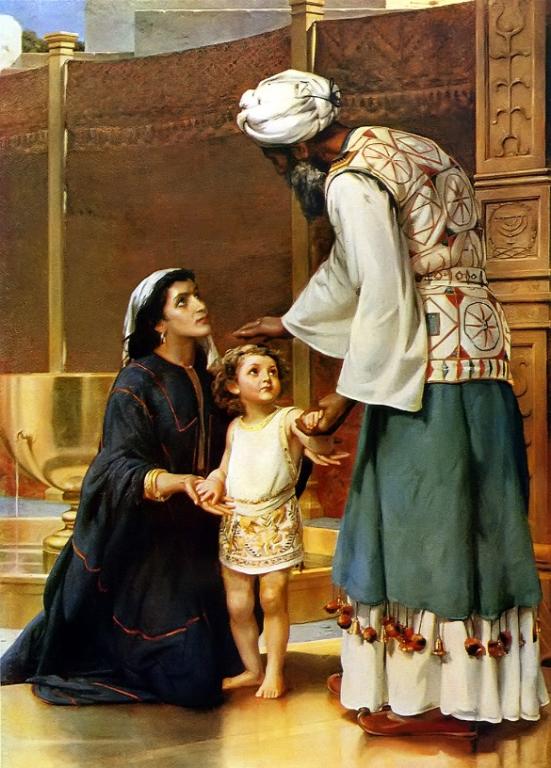
***
This interesting article was posted in Interpreter: A Journal of Latter-day Saint Faith and Scholarship at noon today:
Donald W. Parry, “Ancient Sacred Vestments: Scriptural Symbols and Meanings”
Abstract: In this essay Parry starts with the symbology of ritual vestments, and then discusses in detail how the ancient clothing worn in Old Testament temples are part of the rituals and religious gestures that are conducted by those who occupy the path that leads from the profane to the sacred. The profane is removed, one is ritually washed, anointed, invested with special clothing, offers sacrifices, is ordained (hands are filled), and offers incense at the altar, before entering the veil. Putting on clothes, in a Christian context, is often seen as symbol of putting on Christ, as witnessed by the apostle Paul using the word “enduo,” when talking about putting on Christ, a word mainly used in the Septuagint for donning sacred vestments (symbols also for salvation, righteousness, glory, strength and resurrection) in order to be prepared to stand before God. Parry then goes on explaining how priestly officiants wearing sacred vestments, emulated celestial persons who wear sacred vestments, making one an image of those celestial persons. He concludes with showing how the ancient garbs of the High Priest point to Christ.
[Editor’s Note: Part of our book chapter reprint series, this article is reprinted here as a service to the LDS community. Original pagination and page numbers have necessarily changed, otherwise the reprint has the same content as the original.
See Donald W. Parry, “Ancient Sacred Vestments: Scriptural Symbols and Meanings,” in Temple Insights: Proceedings of the Interpreter Matthew B. Brown Memorial Conference, “The Temple on Mount Zion,” 22 September 2012, ed. William J. Hamblin and David Rolph Seely (Orem, UT: The Interpreter Foundation; Salt Lake City: Eborn Books, 2014), 219–40. Further information at https://interpreterfoundation.org/books/temple-insights/.]
***
And, in addition to Professor Parry’s article, here are links to some other pieces in Interpreter. These were published in prior issue of the journal:
Noel B. Reynolds, “Chiastic Structuring of Large Texts: Second Nephi as a Case Study”
Abstract: In this important paper, Noel Reynolds extends his 1980 argument for the chiastic structure of 1 Nephi to demonstrate that 2 Nephi can be seen as a matching structure with a similar nature. Taken together, these findings demonstrate that chiasmus is not a phenomenon that confines itself to the details of words and phrases at the level of scriptural verses but can extend to much larger units of meaning, allowing the rhetorical beauty and emphasis of their overall messages to shine more brilliantly when they are considered as purposefully crafted wholes.
[Editor’s Note: Part of our book chapter reprint series, this article is reprinted here as a service to the LDS community. Original pagination and page numbers have necessarily changed, otherwise the reprint has the same content as the original.
See Noel B. Reynolds, “Chiastic Structuring of Large Texts: Second Nephi as a Case Study,” in “To Seek the Law of the Lord”: Essays in Honor of John W. Welch, ed. Paul Y. Hoskisson and Daniel C. Peterson (Orem, UT: The Interpreter Foundation, 2017), 333–50. Further information at https://interpreterfoundation.org/books/to-seek-the-law-of-the-lord-essays-in-honor-of-john-w-welch-2/.]
Stephen O. Smoot, “Jacob — The Prophet of Social Justice”
Review of Deidre Nicole Green, Jacob: A Brief Theological Introduction (Provo, UT: The Neal A. Maxwell Institute for Religious Scholarship, 2020). 148 pages. $9.99 (paperback).
Abstract: Deidre Nicole Green, a postdoctoral research fellow at the Neal A. Maxwell Institute for Religious Scholarship, offers an analysis of the theology of the book of Jacob with her new contribution to the Institute’s brief theological introduction series to the Book of Mormon. Green focuses on the theology of social justice in Jacob’s teachings, centering much of her book on how the Nephite prophet framed issues of atonement and salvation on both personal and societal levels. Her volume offers some intriguing new readings of otherwise familiar Book of Mormon passages.
Jasmin Gimenez Rappleye, “Itty Bitty Books with Big Lessons: Enos, Jarom, Omni”
Review of Sharon J. Harris, Enos, Jarom, Omni: A Brief Theological Introduction (Provo, UT: The Neal A. Maxwell Institute for Religious Scholarship, 2020). 144 pages. $9.95 (paperback).
Abstract: Sharon Harris, a professor of English at Brigham Young University, offers an analysis of the theology of the “small books” of Enos, Jarom, and Omni in this next installment of The Book of Mormon: Brief Theological Introductions by the Neal A. Maxwell Institute for Religious Scholarship. Harris argues that the theology of these small books focuses on the covenant with the Nephites and Lamanites, the importance of genealogy, and the role kenosis plays in several of these Book of Mormon prophets. Harris presents both new and familiar readings of these compact books, providing a fair contribution to their study.
Abstract: With a selection of a few notable examples (Zoram, Jarom, Omni, and Mosiah) that have been analyzed by the ongoing Book of Mormon names project, Stephen Ricks argues that “proper names in the Book of Mormon are demonstrably ancient.”
[Editor’s Note: Part of our book chapter reprint series, this article is reprinted here as a service to the LDS community. Original pagination and page numbers have necessarily changed, otherwise the reprint has the same content as the original.
See Stephen D. Ricks, “Proper Names from the Small Plates: Some Notes on the Personal Names Zoram, Jarom, Omni, and Mosiah,” in “To Seek the Law of the Lord”: Essays in Honor of John W. Welch, ed. Paul Y. Hoskisson and Daniel C. Peterson (Orem, UT: The Interpreter Foundation, 2017), 351–58. Further information at https://interpreterfoundation.org/books/to-seek-the-law-of-the-lord-essays-in-honor-of-john-w-welch-2/.]
***
My wife and I received our flu vaccine and our Pfizer COVID-19 booster in the forenoon today. Thus far, I’m feeling no aftereffects at all. Not even a sore or stiff arm. (I didn’t feel one with the first and second Pfizer doses, either.) Of course, I am experiencing sudden and unaccountable urges to surrender my constitutional rights and to pledge my allegiance to a one-world state led by Bill Gates and George Soros. But those must surely be unrelated to vaccines. And I may well be externally shedding vaccine components — so my advice to everybody around me is to mask up, to maintain at least six feet of social distance, and to invest in my new Florida swamp land fund.












